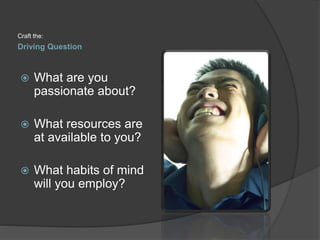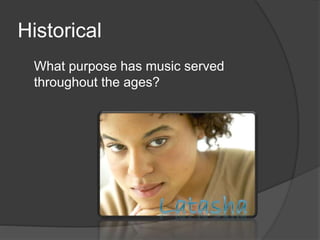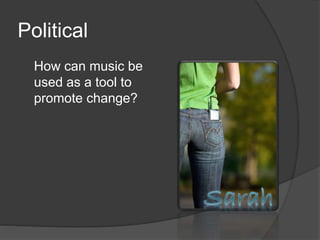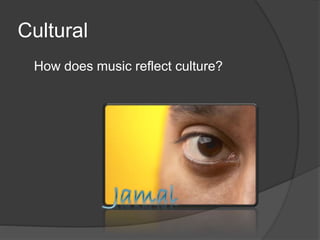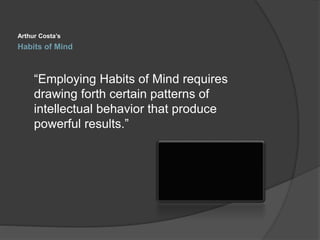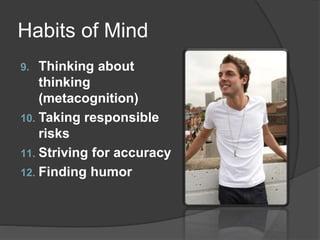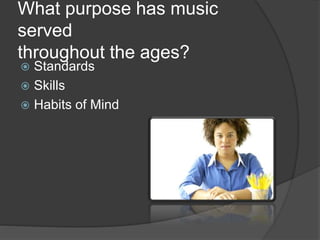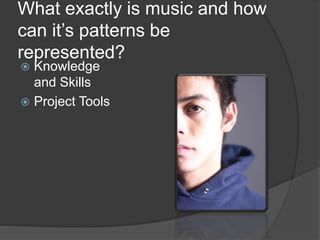A Project Based Learning Example
- 3. mu⋅sic [myoo-zik] –noun1.an art of sound in time that expresses ideas and emotions in significant forms through the elements of rhythm, melody, harmony, and color.
- 4. Driving Question Craft the: What are you passionate about? What resources are at available to you? What habits of mind will you employ?
- 5. Historical What purpose has music served throughout the ages?
- 6. Political How can music be used as a tool to promote change?
- 7. Mathematical What exactly is music and how can it’s patterns be represented?
- 8. Interpersonal How are men's and women's roles defined though music?
- 9. Cultural How does music reflect culture?
- 10. Habits of Mind Arthur Costa’s “Employing Habits of Mind requires drawing forth certain patterns of intellectual behavior that produce powerful results.”
- 11. Habits of Mind 1. Persisting 2. Thinking and communicating with clarity and precision 3. Managing impulsivity 4. Gathering data through all senses
- 12. Habits of Mind 5. Listening with understanding and empathy 6. Creating, imagining, innovating 7. Thinking flexibly 8. Responding with wonderment and awe
- 13. Habits of Mind 9. Thinking about thinking (metacognition) 10. Taking responsible risks 11. Striving for accuracy 12. Finding humor
- 14. Habits of Mind 13. Questioning and posing problems 14. Thinking interdependently 15. Applying past knowledge to new situations 16. Remaining open to continuous learning
- 15. Details Now, let’s flesh out the: Standards Skills Habits of Mind
- 16. What purpose has music served throughout the ages? Standards Skills Habits of Mind
- 17. History Standards Benchmark 2: The student uses a working knowledge and understanding of individuals, groups, ideas, developments, and turning points of the Age of Revolutions (1650-1920). Benchmark 5: The student engages in historical thinking skills.
- 18. 21st Century Skills Analyze and evaluate major alternative points of view Develop, implement and communicate new ideas to others effectively Be open and responsive to new and diverse perspectives; incorporate group input and feedback into the work
- 19. Habits of Mind Listening with understanding and empathy Questioning and posing problems
- 20. Assessment? How will I use: Products Artifacts Criteria
- 21. How can music be used as a tool to promote change? Products Artifacts Criteria
- 22. Products Research brief on music and social change Campaign outline for music to promote environmental change Original song with lyrics
- 23. Artifacts Compilation of anti-war songs Compilation of civil rights songs Images of social change movements involving music
- 24. Criteria Definition for social change Research rubric Campaign rubric
- 25. Mapping the Project Steps involved in: Knowledge and Skills Needed Already Have Learned Taught Before the Project Taught During the Project Project Tools Know / need to know lists Daily goal sheets Journals Briefs Task lists Problem logs
- 26. What exactly is music and how can it’s patterns be represented? Knowledge and Skills Project Tools
- 27. Knowledge and Skills Know ratios - Need to know Pythagorean Scale Know pitch – Need to know frequency
- 28. Project Tools Student planning brief Daily math lessons Listening Journal Website lists Problem solving log
- 29. Student Planning Brief The devils in the details… Overall challenge Investigation Activities What will I do? How will I do it? Date due Resources and support
- 30. How are men's and women's roles defined though music? Overall challenge Investigation Activities Resources and support Enduring understandings
- 31. Overall Challenge “The overall challenge in this project is to make sound generalizations based on data found in American song lyrics through different social eras.”
- 32. Investigation “I intend to investigate song lyrics written by both sexes during different social eras in America, comparing and contrasting this data to primary resources from the varying eras.”
- 33. Activities Song Lists I need to compile a list of the top ten songs from the following eras… I will begin with internet searches I will spend one week on this activity Lyrics I need to locate lyrics for songs I need to analyze lyrics for themes I will spend two weeks on the activity
- 34. Resources and Support Internet History teacher Music teacher Librarian Jessica
- 35. Enduring Understandings Music reflects desire as well as reality The roles of men and woman have changed through- out history The dynamics of relationships are complicated
- 36. End of Project Reflection What does this mean to me? Explain how the essential question or problem statement for the project was resolved. This reflection should encompass all project content and outcomes, and provide an understanding of the student’s thought processes as the project progressed.
- 37. How does music reflect culture? “I found that music reflects culture in many ways, through instrument craftsmanship, song lyrics, methods of sharing, and its use in religious and other ceremonies. I had no idea that music was so embedded in people’s culture.”
- 39. Begin… Begin with the End in Mind Craft the Driving Question Plan the Assessment Map the Project Planning Reflect
Editor's Notes
- #2: This presentation will show you an example of project-based learning though the eyes of five students and their unique perspectives.
- #3: The example we will be looking at is an exploration of, “What is music?”
- #4: You are already familiar with definitions of words and concepts. Definitions are not what project-based learning is about. The way you eventually answer your question will be much more personal. It won’t be the kind of answer you can just find on the Internet or in a book. Speaking of questions, let’s look at how you will form one.
- #5: The kind of question one starts with in project-based learning is called an essential question. Sometimes these questions are provided by the teacher, and sometimes they are created by the student. When forming an essential question, remember to think big! The question should be open, deep, and interesting. See our website under PPBL for more resources on writing your driving question. For now, let’s look at the five questions our guest students wrote. Notice how all of their questions relate to our original question, “What is music?”
- #6: Latasha is taking a historical approach when she asks, “What purpose has music served throughout the ages?” As you think about her question, where does your mind go?
- #7: Sarah is very interested in the environment, and she has found a way to incorporate this when she asks, “How can music be used as a tool to promote change?”
- #8: Sam marches to the beat of his own drummer and wants to know, “What exactly is music and how can it’s patterns be represented?”
- #9: Marc has found a way to explore relationships through music when he poses the question, “How are men's and women's roles defined though music?”
- #10: Jamal’s question is a simple one, but something he is deeply interested in exploring, “How does music reflect culture?” As these students embark on their journeys to find answers to their questions, they will need to employ some new ways of thinking. These new ways of thinking can be referred to as habits of mind. You will be employing them as well as you work on your projects.
- #12: Let’s quickly list Arthur Costa’s 16 habits of mind. 1) Persisting, 2) Thinking and communicating with clarity and precision, 3) Managing impulsivity, 4) Gathering data through all senses…
- #13: 5) Listening with understanding and empathy, 6) Creating, imagining, innovating, 7) Thinking flexibly 8) Responding with wonderment and awe
- #14: 9) Thinking about thinking or metacognition 10)Taking responsible risks, 11) Striving for accuracy 12) Finding humor
- #15: 13) Questioning and posing problems, 14) Thinking interdependently, 15) Applying past knowledge to new situations, and 16) Remaining open to continuous learning. Don’t worry, you don’t need to memorize these, you will be seeing them again as you plan your project.
- #16: The next step in project based learning is to flesh out some of the details. Don’t worry, you won’t have to have them all laid out at the beginning, just a sketch of what you plan on doing.
- #17: Let’s look how Latasha plans on addressing standards, skills, and habits of mind in her project as she explores, “What purpose has music served throughout the ages?”
- #18: Latasha plans on addressing two history benchmarks from the state standards. She will probably meet many more as the project plays out, but these are a couple she knows right up front she will meet.
- #19: Latasha also knows she will be developing these 21st Century Skills as she researches and interviews people related to her project.
- #20: As Latasha works her way though her project, she will be practicing listening with understanding and empathy as well as questioning and posing of problems.
- #21: Another important part of project-based learning is assessment. It will look very different from the multiple choice tests you may be familiar with as you will not only be designing your own project, but the “tests” and “answer keys” as well!
- #22: These “tests” will be in the form of products you will create and artifacts you will collect. Let’s see how Sarah designed her assessments that will judge how well she has answered her question, “How can music be used as a tool to promote change?”
- #23: Sarah will write a research brief on how music has been used to promote social change. She then plans on creating her own music campaign to promote change in people’s views on the environment. As part of her project, Sarah will be writing an original song complete with lyrics which will become part of her campaign.
- #24: Sarah knows that music has been used to promote change in other important issues, and she will begin by compiling both anti-war and civil rights songs and images. She plans on learning from the past as she plans for the future.
- #25: Sarah will be creating rubrics for her research and campaign products. She also feels she must formally define social change at the beginning of her project.
- #26: As Sam moves deeper in his project plan, he begins to list the knowledge and skills he will need as well as the tools used to document the process.
- #27: When answering, What exactly is music and how can it’s patterns be represented?”, where would you start?
- #28: Sam found he already understands ratios, but that he would need to stretch that learning and also become familiar with the Pythagorean Scale as he explores sound waves. As a long time music student, Sam is very familiar with the concepts of pitch, but sound frequency is a new concept to him and he will have to locate resources to expand his learning.
- #29: To keep track of all this learning, Sam plans on employing a variety of documentation tools. This is particularly important in Sam’s project, as his project products will be more learning based than something physical that can be seen by others.
- #30: Eric had a hard time selling his idea to his teachers who secretly suspected him of just trying to figure out how to spend more time with Jessica! After he shared his student planning brief with his teachers, however, they saw that Eric was as serious about his guiding question as he was about his girlfriend.
- #31: Let’s look in detail at how Eric plans on answering the question, “How are men's and women's roles defined through music?”
- #32: First off, Eric understands the overall challenge of his particular project. His project will need to be grounded in hard data from valid resources.
- #33: Eric wants to make sure that his project is reflective of many viewpoints, and plans on comparing this findings to other non-musical documents from the varying eras he will be studying.
- #34: Some of the specific activities Eric will be involved with include searching though thousands of web pages. It is important that Eric has a timeline going into his project, or he could get lost in the data!
- #35: Eric will probably need some help as well. He plans on contacting his teachers in both history and music, as well as the librarian. He even added Jessica for moral support.
- #36: Just in case you thought Eric’s project was fluff, look what he will come away understanding at the end of this project. These enduring understandings will serve him well in the years to come.
- #37: Every project comes to an end. This is the time for reflection on what was learned as well as on what you may do differently next time. It is also the time to formally “answer” your guiding question. Let’s listen to part of Jamal’s reflection.
- #39: Now I would ask, what is your question? Go ahead and give it a try. Write a guiding question based on the essential question, of “What is yours?”
- #40: You will find all the documents you will need to manage the process on our website. Go ahead and begin!


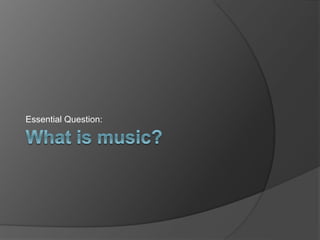
![mu⋅sic
[myoo-zik] –noun1.an art of sound in time that expresses
ideas and emotions in significant forms through the elements
of rhythm, melody, harmony, and color.](https://image.slidesharecdn.com/apblexample-150426172111-conversion-gate01/85/A-Project-Based-Learning-Example-3-320.jpg)
